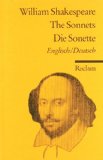Interpretation von Shakespeares 18. Sonnet
 In the following I am going to analyse Shakespeares Sonnet 18, also known as Shall I Compare.
In the following I am going to analyse Shakespeares Sonnet 18, also known as Shall I Compare. Its theme is a comparison between an unidentified person and summer. The sonnets structure of three quatrains and a heroic couplet at the end of the rhyme scheme makes it a typical Shakespearean or Elizabethan Sonnet. Here, instead of a basic structure of two parts laid over three, we find a structure of two parts laid over four. The two parts are the three quatrains, on the one hand, and the concluding or resolving couplet, on the other.
Shakespeare compares the unidentified person to summer by listing up summers deficiencies and contrasting them to the unidentified persons beauty. These comparisons and descriptions are supported by several stylistic devices. Aside from the stylistic devices, Shakespeare's is dominated by the word field of nature, for example buds of May, the eye of heaven or rough winds which play an important role in the characterization of summer.
Then, Shakespeare starts listing up summers deficiencies. Here it says that in summer, there are often storms which can lead to the destruction of buds or flowers because their beauty is very sensitive and vulnerable. In addition, the reader is reminded of summers brevity, because summers lease hath all to short a date which means that its beauty is transitory, theres no way to stop its brevity.
In the next two lines (5-6) which are the beginning of the second quatrain, Shakespeare puts emphasis on summers high temperatures which can make you feel uncomfortable, because you have to sweat. Moreover, its possible that you feel cold if the sky is covered with clouds covering the sun.
In lines 7-8, Shakespeare additionally draws the conclusion that nothing on earth can escape from destruction, every fair from fair sometime declines. Its a law of nature that everything on earth is subject to. Either you will die from old age or from fortuitous circumstances.
So in the first two quatrains, Shakespeare describes summers negative side whereas in the third quatrain he complicates the whole situation contrasting summers deficiencies to the unidentified persons beauty. Here, Shakespeare gives examples of options the unidentified person's beauty possesses in contrast to the summer.
In lines 9-12, the third quatrain, the reader gets to know that the unidentified persons beauty is eternal and remains unchanged, perfectly reflected by a paradox in line 9 which contrasts eternal to fade.
In addition, there's a front position of words, putting emphasis on the fact that the unidentified persons beauty is exactly not what summer is. Here, Shakespeare uses the word But. Furthermore, we can find the figure of anaphora in lines 10 and 11 which enforces the eternal character of the unidentified persons beauty. His beauty is immortal and thats why he can grow older and older and perhaps even become more lovely and temperate in the future.
At the beginning of lnie 13, the turn occurs which is a logical or emotional shift to take an enlarged view of the subject.
So now, Shakespeare makes it clear in the first line of the heroic couplet that as long as the world exists, as long as men can breathe or eyes can see, the unidentified persons beauty will not die or fade because it is preserved in the poem. This astonishing fact is enforced by the repetition of the words So long as.... It isnt subject to the law of nature anymore, because this poem gives life to thee.
So the heroic couplet releases the pressure because now we know that this unidentified person is a higher power, the goddess of poetry, a muse that is often responsible for the poet's creativity and ideas.
Inhalt
Interpretation von William Shakespeares Sonnet "Shall I Compare" in Englisch
* Thema des Gedichts
* Zeilen- bzw. strophenweise Analyse
* Rhetorische Figuren im Sonnet
(Englisch LK NRW) (671 Wörter)
* Thema des Gedichts
* Zeilen- bzw. strophenweise Analyse
* Rhetorische Figuren im Sonnet
(Englisch LK NRW) (671 Wörter)
Hochgeladen
von unbekannt
Schlagwörter
Optionen
2 weitere Dokumente zum Thema "Werke"
97 Diskussionen zum Thema im Forum
97 Diskussionen zum Thema im Forum
- Shakespeares sonnet 18 (2 Antworten)
- sonnet 128 (3 Antworten)
- shakespearen sonnet (0 Antworten)
- Shakespeare Sonnet (0 Antworten)
- shakespeare ;-) (3 Antworten)
- mehr ...
Wenn du dieses Dokument verwendest, zitiere es bitte als: "Interpretation von Shakespeares 18. Sonnet", https://e-hausaufgaben.de/Hausaufgaben/D4823-Hausaufgabe-Englisch-Interpretation-von-Shakespeares-18-Sonnet.php, Abgerufen 16.12.2025 17:20 Uhr
Es handelt sich hier um einen fremden, nutzergenerierten Inhalt für den keine Haftung übernommen wird.
Es handelt sich hier um einen fremden, nutzergenerierten Inhalt für den keine Haftung übernommen wird.
ÄHNLICHE DOKUMENTE:
- Shakespears "Sonnet 18"Interpretation von Shakespears Sonnet 18
- Sonett XVIII (18) von ShakespeareReferat auf Englisch zu William Shakespeare und seinem Sonett 18, auch "Shall I Compare": Kurzbiografie Shakespeare, Analyse und..
- mehr ...
PASSENDE FRAGEN:
- Shakespeares sonnet 18kennt jemand ne gute site zu diesem sonnet suche interpretationen etc. möglichst in gutem englisch
- sonnet 128huhu... ich habe ein problem, ich brauche eine interpretation zum sonnet 128 von shakespeare...das problem ist nur, dass ich ..
- shakespearen sonnethallo, mich würde interessieren worüber shakespeare in seinen sonnets geschrieben hat. ich habe mal sein bekannntestes sonnet..
- Shakespeare SonnetHallo :) ich schreibe in englisch eine Arbeit über Gedichtsanalyse. Unsere Lehrerin meinte, dass ein Sonnet zwischen dem ..
- shakespeare ;-)hey leute ich hab ne frage:) hat jemand vllt. ne zusammenfassung aller hauptthemen der sonette von shakespeare? also zum ..
- mehr ...
